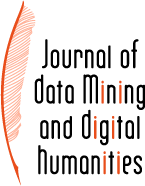 |
Hadeel Saadany ; Emad Mohamed ; Raheem Sarwar - Towards a Better Understanding of Tarajem: Creating Topological Networks for Arabic biographical Dictionaries
jdmdh:8990 - Journal of Data Mining & Digital Humanities, 7 juin 2023 - https://doi.org/10.46298/jdmdh.8990- 1 University of Wolverhampton
- 2 Centre for Translation Studies, University of Surrey
- 3 Centre for Translation Studies [University of Surrey]
- 4 School of Management, University of Bradford
- 5 School of Management [Bradford]
- 6 Manchester Metropolitan University
- 7 Manchester Metropolitan University Business School
- 8 Faculty of Business and Law, Manchester Metropolitan University
- 9 University of Manchester [Manchester]
Biographical writing is one of the earliest and most extensive forms of Arabic literature. Some scholars tend to assume that classical Arabic biographies, widely known as Tarāǧim, arose in conjunction with the study of the reliability of the Hadith transmitters (the reciters of the Prophet Mohammad's sayings) which lead to a proliferation of biographical material collected and used to assess the transmitter's trustworthiness . However, a scrutiny of the well-known classical Arabic biographical dictionaries such as Siyaru 'A`lāmi an-Nubalā' `The Lives of the Noble Figures' for Adh-Dhahabī shows that they extend their entries to other classes of persons important to the development of particular fields such as Islamic jurisprudents, rulers, poets, philosophers or physicians. The main contribution of Arabic biographical dictionaries is the cumulative value of the thousands of life histories which construct a picture of the Islamic society in different eras. An Arabic biographical dictionary, therefore, is predominantly used by scholars to look up an eminent person's achievements and historical background. In this project, however, we explore Arabic biographies as a prosopography, rather than a biography in the strict sense. We introduce a novel method for a better understanding of Arabic biographical dictionaries by creating a network of relations among different persons. We utilise Natural Language Processing (NLP) tools to create a topological network from the unstructured data of 45,500 biographical entries collected from different dictionaries. We aim to illustrate how network analysis leveraged by NLP tools can provide scholars with innovative methods for discovering complex constellation of relations between prominent and non-prominent figures spanning over several eras and from different fields of knowledge. We also use graph visualisation as a means to effectively communicate and explore such complex constellations. Each network visualisation is purposefully designed to be as simple and robust as possible to offer scholars a way to move relatively fluidly between the large scale of biographical entries and to easily interpret the minute ties between persons of different walks of life. We make both our data and code publicly available for researchers to replicate the experiment. It can be found at:https://github.com/sadanyh/Relational-Network-for-Arabic-Tarajem
